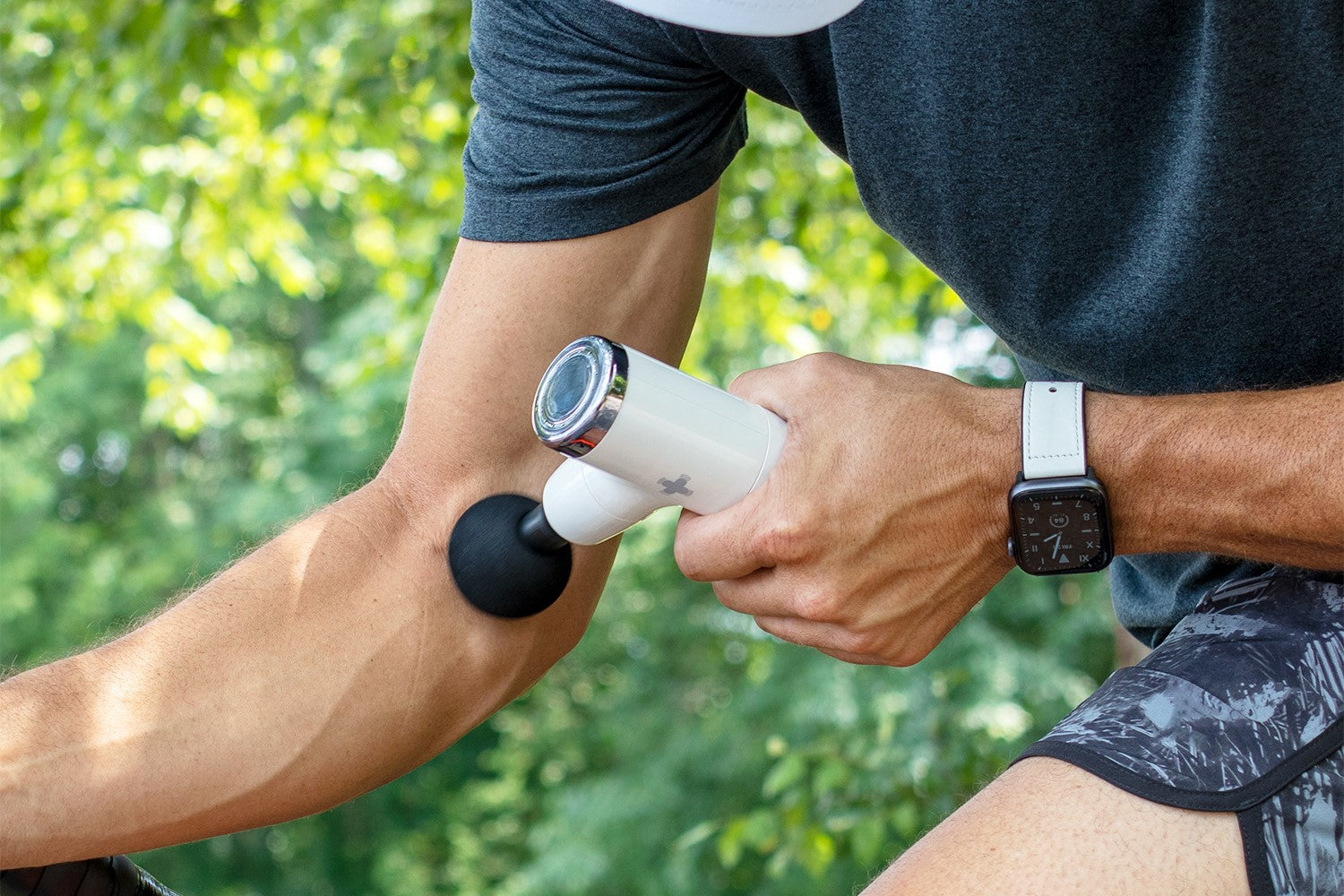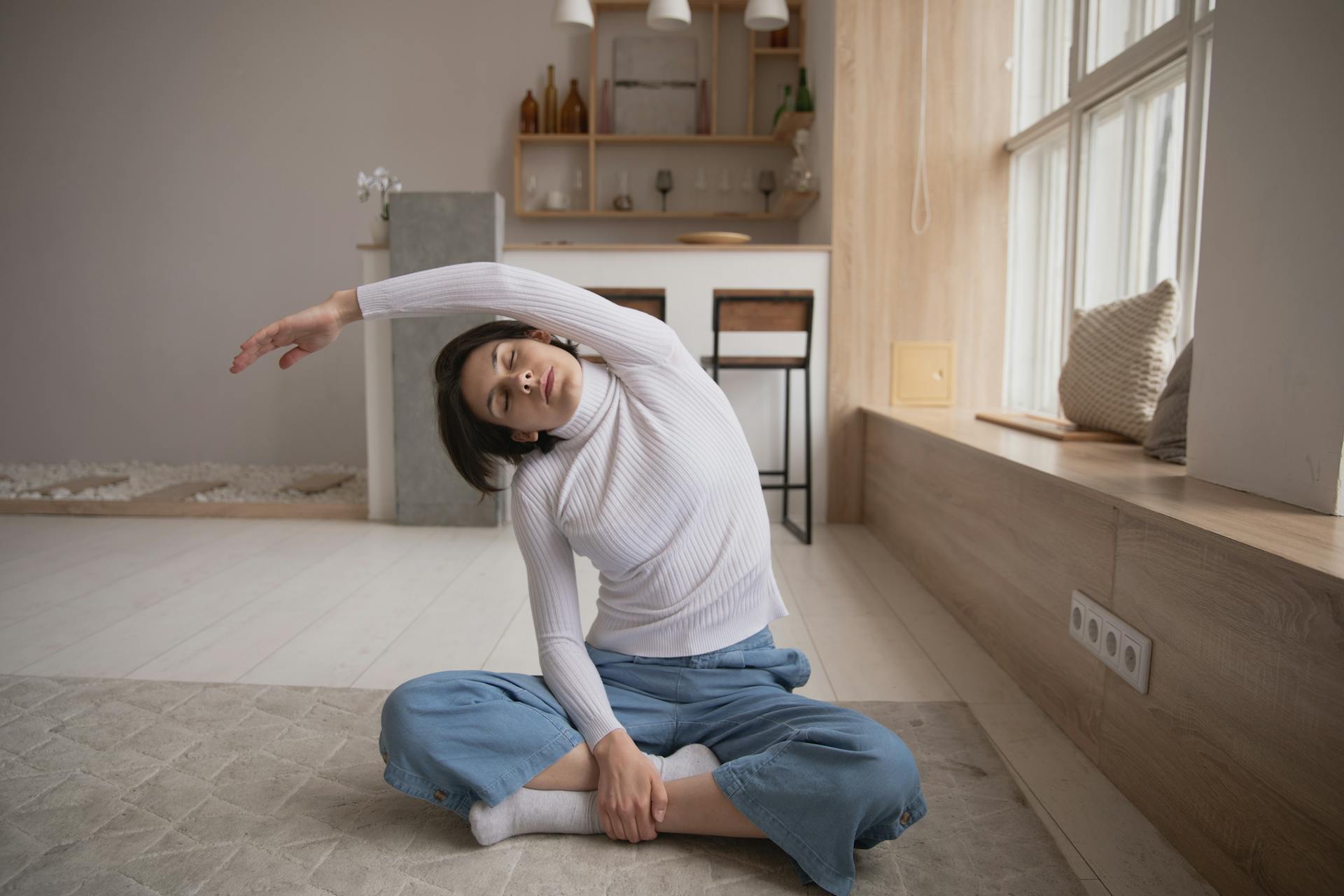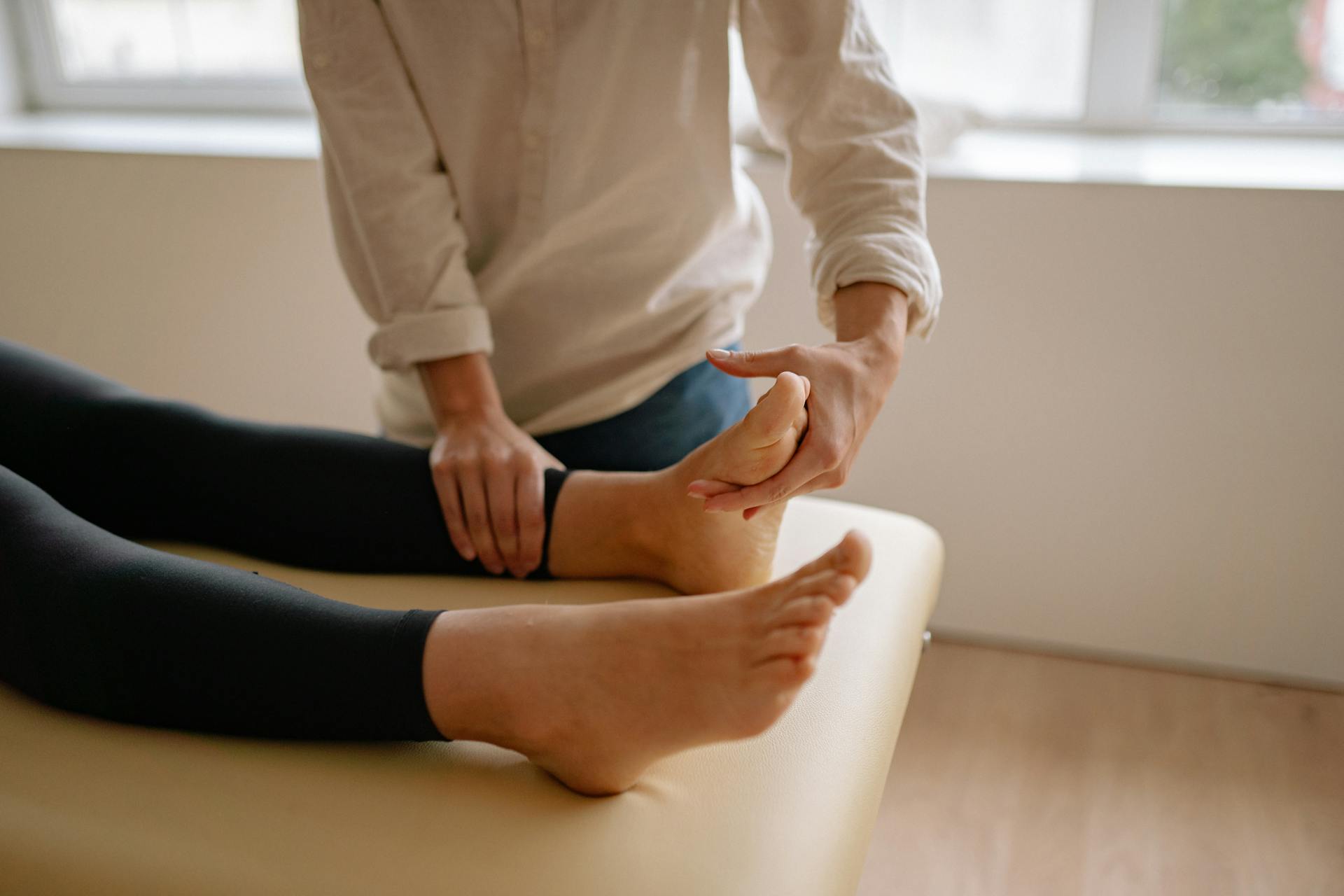Whether you’re a long-time athlete or just starting to work out, you’re probably no stranger to delayed onset muscle soreness (DOMS). This achy condition creeps up in the days following a tough workout, and it can be a pain.
Luckily, a combination of sleep, nutrition, and stretching can often get you through the recovery process. But if your post-workout aches have been disrupting your life, can massage for DOMS help? What are the benefits of massage therapy, and is it really worth adding to your routine?
Below, we’ll cover everything you should know about massage for DOMS, including the benefits, research, and best ways to get started.
What Is Delayed Onset Muscle Soreness (DOMS)?
So, what exactly is delayed onset muscle soreness, and why does it happen?
In a nutshell, DOMS occurs when muscle fibers suffer wear and tear from exertion that exceeds your usual routine. For example, a tough workout, your first-ever gym session, or any activity outside of your norm can lead to symptoms of DOMS.
While many activities can lead to soreness, eccentric exercise is one of the biggest culprits. This is because it causes your muscles to lengthen under tension. In turn, it can lead to more strain on the fibers. Examples of eccentric movements include the downward motion of pull-ups and the lowering motion of deadlifts.
When muscle fibers become damaged, it triggers a natural, inflammatory repair process. This is a vital part of muscle recovery, but it can also come with the hallmark pain and stiffness of DOMS.
Who Gets DOMS?
As mentioned above, delayed onset muscle soreness typically occurs when you’re pushing your muscles past their usual limits.
You might deal with this condition when you:
- Start a new workout routine after being out of the gym for a long time
- Begin a new, physical job that requires you to use your muscles in different ways
- Practice progressive overload (aka small increments in intensity, weight, or duration) during your workouts
How Long Does DOMS Last?
The symptoms of DOMS often start showing up anywhere from 12 to 24 hours post-workout. From there, they can last anywhere from one to three days (and maybe a bit longer if the activity was especially intense.)
The good news is that while DOMS can be a nuisance, it’s usually nothing to worry about — and once you’re healed up, you can get back in action with muscles even stronger than they were before.
What Are the Benefits of Massage for DOMS?
You probably know that a massage feels great when you’re sore — but what exactly can it do for DOMS? Here are some of the benefits of massage for muscle soreness, along with the research we have so far.
Massage Can Ease Sensations of Pain
When you’re dealing with achy, fatigued muscles, a simple massage can bring some short-term pain relief. A small 2005 study found that 10 minutes of massage, 3 hours after elbow flexion exercises, helped to reduce the severity of DOMS by 30%.
But how exactly does massage provide these pain-relieving benefits?
Aside from reducing stress and tension, one theory suggests that it can soothe pain by “closing the pain gate.” In other words, it may alter the way we perceive pain by stimulating the nerve fibers near achy areas, providing immediate comfort and relief.
Supports Range of Motion (ROM) and Flexibility
Delayed onset muscle soreness can cause some serious stiffness in the days after intense activity. Fortunately, a few minutes of massage may help to decrease tension and support your mobility while you heal.
A 2020 meta-analysis in the journal BMJ Open Sport & Exercise Medicine found that sports massage, while not directly impacting the performance of muscles, may have a small impact on flexibility compared to no intervention. Beyond that, a 2017 review found that massage may also improve shoulder ROM.
Improves Fatigue and Soreness
In one 2018 meta-analysis, massage was compared to a range of recovery options — including compression, active recovery, and more. Remarkably, the results found that massage showed the greatest impact on perceived fatigue and DOMS.
As a whole, a good massage can help you reduce stress, get deeper sleep, and support healthy blood flow — all of which can lead to you having a smoother recovery from your post-workout aches.
What Are the Best Massage Techniques for DOMS?
With all of the benefits of massage in mind, you might wonder: What are the best ways to try it out?
There are countless ways to try this natural therapy — from manual self-myofascial release (SMR) to visiting a spa and more. To get started, here are five of the best methods to consider adding to your routine:
1. Massage Gun

If you spend any time in the fitness space, chances are you’ve heard people raving about massage guns.
These small, portable devices use high-speed vibrations to break up knots and boost blood flow. They also come with several different head attachments to tackle varying needs. For example, the ball attachment offers a broader, more soothing massage, while the fork-shaped head can help you knead muscles with more precision.
(Tip: When working on currently-sore areas, it’s important to keep your massage gun settings relatively light. But you can also use it before a workout, after a workout, and for general stress relief.)
Try: Massage Gun for Biceps and Triceps
Here’s a quick massage gun routine to try when you notice soreness in your biceps and triceps:
- Connect the round, soft head attachment to your massage gun.
- Sit in a comfortable space with a pillow resting on your lap.
- Turn on the device, and select a light pressure.
- Rest your arm on the pillow, palm up, with your elbow slightly bent.
- Gently glide the device over the bicep at an angle for 10 to 20 seconds. (Note: Be sure to avoid the crux of the elbow, since this area can be sensitive.)
- Then, lift your arm and reach around with the massage gun to target the triceps. Again, lightly glide the massage gun along the area, allowing the high-pressure bursts to massage for 10 to 20 seconds.
- Rotate between the muscles for a total of one minute.
Try: Massage Gun for Quads
DOMS in the quads can be a sign of a workout well done, but it can also make everyday activities — like walking downhill or hopping in the car — painful.
Fortunately, this quad-focused massage gun routine may be able to help:
- Start by attaching your desired massage gun head. (The fork attachment will work excellently here, but you can also use the ball attachment if you like.)
- Like the previous technique, begin by switching your massage gun to a light setting.
- Glide the device along the quads at an angle for 10 to 20 seconds.
- Then, increase the intensity to your desired pressure. (Note: The massage should feel soothing and relaxing here. If it causes pain or excessive discomfort, be sure to dial back the intensity.)
- Continue to glide along the quads for a total of one minute on each leg.
2. Foam Rolling
When it comes to massage for DOMS, self-myofascial release has a reputation for being one of the most effective (and easiest) options out there. The most popular SMR technique is foam rolling — which uses steady, continuous pressure to break up tension in the soft tissue.
Foam rollers are cylindrical tools that come in a range of sizes, styles, and densities. Solid, textured rollers are typically best for trigger points and large muscles. On the other hand, softer rollers are better for lighter massage and more delicate areas. In any case, these tools are useful for both warming up your muscles before a workout and relieving soreness afterward.
With these benefits in mind, here are two ways to give foam rolling a try:
Try: Foam Roller Calf Massage
If you’re an avid runner or hiker, you’re likely familiar with the discomfort that comes with stiff, overworked calves. The good news is that foam rollers make it easy to target and release tension in these busy muscles.
Simply follow these steps to get started:
- Sit in a comfortable area with your legs extended. (You won’t need a ton of space for this exercise — just a little more than the length of your body should do the trick.)
- Position the foam roller underneath your left calf.
- Use your arms and right leg to lift your body off the ground, with your calf still balancing on the roller.
- Roll forward and backward to massage the muscle. For even deeper relief, you can flex your foot and point your toes in the air while you roll.
- Continue for one to two minutes, and repeat with the opposite leg.
Try: Foam Rolling for Glutes
Your gluteal muscles are the powerhouses of your lower body, playing a crucial role every time you walk, lunge, jump, or run. And because they’re responsible for so many movements, they can end up sore from a wide range of exercises — including Bulgarian split squats, deadlifts, or even sprints.
Fortunately, foam rollers enable you to target and relieve tension deep within these muscles. Simply:
- Sit with your legs extended and the roller positioned under your glutes.
- Lift your body off the ground.
- Begin the massage by rolling back and forth using slow, controlled motions for 30 seconds.
- To isolate either side, you can cross one leg over the other and rotate your body as you roll. (This technique can also help you relieve tight gluteus medius and minimus muscles, which can hold a surprising amount of tension.)
- Roll for a total of two minutes.
3. Oscillating Massagers

Oscillating massagers are similar to massage guns in the way that they offer an effortless massage experience. However, devices like the MedMassager Body Massager Plus don’t use high-powered percussive therapy. Instead, they use vibrational, oscillating technology to promote relaxation and pain relief.
Tools like these are helpful when you want a more soothing, all-over massage for DOMS. To use one, you’d simply start it at a light intensity and apply it to your sore areas. After a minute or so, you could increase the pressure as needed, allowing it to work its magic for a total of 10 to 15 minutes.
4. Massage Balls
If you notice trigger points after workouts, a tennis ball (or another massage ball) can be a powerful tool to add to your recovery arsenal. Here are the steps to using one:
- Warm up the muscles by gently rolling the ball over your target area. Typically, this is done by placing the ball between your body and a wall or the ground. This position allows you to use your body weight to adjust the massage pressure.
- When you roll over a muscle knot, pause and hold the pressure for 10 to 20 seconds. (Remember: Releasing a knot can sometimes come with a bit of discomfort — but it should not be outright painful.)
5. Professional Massage Therapy
Many athletes regularly visit a masseuse to prevent injury, soothe soreness, and maintain muscle health. But even if you don’t consider yourself an athlete, professional massage can make a big difference when you’re dealing with frequent muscle pain.
So, what are the most popular massage modalities for recovery? The top options include:
- Sports massage therapy, which uses customized techniques to ease pain, improve range of motion, and facilitate healing
- Swedish massage, which uses soothing techniques for whole-body well-being
- Deep tissue massage, which uses deep pressure to break up adhesions and work the inner layers of the muscles
How Soon Should You Use Massage After a Workout?
To help keep DOMS at bay, use your massage tool of choice — whether that’s a rolling session, a massage gun, or your own two hands — within a few hours after your workout.
In addition, be mindful of the pressure of your post-workout massage. It’s best to avoid deep tissue massage right after exercise, simply because it may be too intense for muscle fibers that are currently damaged or inflamed.
While deep tissue techniques definitely have their time and place, most experts suggest sticking to lighter-pressure massage on the days of your workouts.
When Not to Use Massage for DOMS
Massage therapy offers a host of restorative benefits and is usually very safe. However, it’s not always the right choice for everyone.
Ask your doctor about massage if you have any conditions that may be affected by pressure — such as blood clotting disorders, high blood pressure, or skin conditions. Additionally, avoid massage if your soreness is beyond mild-to-moderate, as this can sometimes be a sign of a more serious condition.
Other Ways to Boost Your Muscle Recovery
Massage is great when you’re looking for an easy, relaxing remedy for DOMS — but it’s not the only thing that can bring relief.
It may sound counterintuitive, but more movement in the form of low-intensity exercise can also help you reduce symptoms of DOMS. This is known as active recovery, which can help boost circulation, promote healing, and help keep your soreness to a minimum.
To include active recovery in your routine, you can try:
- Light cycling
- A short walk
- Swimming
- Dynamic stretching or yoga
In addition to movement, you can also try the following remedies for faster relief:
- Cold therapy: Try a cold shower, a quick ice bath, or a short session with a cold pack to help combat inflammation.
- Heat therapy: Grab a heating pad or take a warm bath to reduce muscle tension.
- Restful sleep: Make sure you get seven-plus hours of quality sleep every night to give your muscles the time they need to recover fully.
The Takeaway
When you’re dealing with DOMS, a good massage can help soothe soreness and boost your overall well-being. But before you grab your foam roller or massage gun, remember to stay mindful of the pressure you use — especially after a vigorous workout. Less is often more when it comes to achy muscles, and it’s best to start with light pressure and adjust from there.
Finally, the benefits of massage for DOMS can vary depending on the massage you choose, along with your needs as an individual. If you’re looking for a more personalized approach, don’t hesitate to check with your doctor or visit a certified sports massage therapist near you.
Relieve Sore Muscles with Restorative Home Massage
If you’re ready to elevate your recovery routine from the comfort of your home, the tools from MedMassager can help. View the collection here, or learn more about their many therapeutic uses today.



